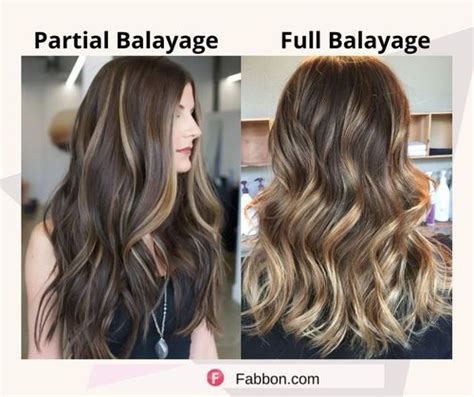What Is Balayage?
Balayage is a French hair coloring technique that uses a freehand painting motion to create natural-looking, sun-kissed highlights. This technique offers a more subtle and blended look than traditional foil highlights, resulting in a seamless transition from darker roots to lighter ends.

Partial vs Full Balayage
Partial Balayage
- Definition: Involves highlighting only a portion of the hair, typically around the face, bangs, or crown.
-
Benefits:
- Less expensive than a full balayage
- Faster appointment time
- Less damaging to the hair
-
Drawbacks:
- May not provide as dramatic a change as a full balayage
- Can be less effective on dark hair
Full Balayage
- Definition: Highlights the entire head of hair, creating a more even and sun-kissed effect.
-
Benefits:
- More dramatic and noticeable change
- More versatile for different hair colors and styles
-
Drawbacks:
- More expensive than a partial balayage
- Longer appointment time
- Can be more damaging to the hair
Key Differences
| Feature | Partial Balayage | Full Balayage |
|---|---|---|
| Coverage | Only a portion of the hair | Entire head of hair |
| Cost | Less expensive | More expensive |
| Time Required | Less time-consuming | More time-consuming |
| Damage to Hair | Less damaging | More damaging |
| Effect | Subtle, natural-looking highlights | Dramatic, sun-kissed highlights |
Choosing the Right Option
The best choice between partial and full balayage depends on your individual preferences and hair goals:
- If you want a subtle, natural look that frames your face and adds dimension: Partial balayage.
- If you want a more dramatic change that brightens your entire head of hair: Full balayage.
- If you have fine or damaged hair: Partial balayage to minimize further damage.
- If you have a lot of gray hair: Full balayage to blend and conceal the gray.
- If you have limited time or budget: Partial balayage.
Balayology: A New Word for Understanding Balayage
Balayology (n.): The study and art of balayage, encompassing the science, techniques, and aesthetic principles of the coloring process. This term reflects the complex and evolving field of balayage, combining technical expertise with artistic creativity.
Advantages of Balayage
- Natural-looking results: Balayage mimics the way the sun naturally lightens hair, creating seamless highlights and lowlights.
- Versatile: Suitable for all hair types and lengths, from fine and straight to coarse and curly.
- Low-maintenance: Balayage does not require frequent touch-ups compared to traditional highlights, growing out gracefully.
- Damage prevention: Balayage involves less chemical application and heat than other highlighting techniques, minimizing hair damage.
- Personalized: Can be customized to suit individual style preferences, face shape, and hair color.
Disadvantages of Balayage
- Expertise required: Balayage requires skilled and experienced stylists to achieve optimal results.
- Time-consuming: Full balayage can take several hours to complete.
- Expensive: Balayage can be more expensive than other highlighting techniques.
- Multi-session process: Darker hair may require multiple sessions for desired results.
- Can fade: The sun, heat, and styling products can gradually fade balayage highlights.
Tips and Tricks for Perfect Balayage
- Consult with a reputable stylist: Choose a stylist who specializes in balayage and understands your hair type and goals.
- Discuss your desired results: Clearly communicate your vision and provide reference photos for inspiration.
- Use high-quality products: Invest in professional-grade hair color products designed for balayage.
- Protect your hair: Avoid heat styling and use UV protectants to prevent color fading.
- Refresh your highlights: Schedule regular touch-ups to maintain your balayage and keep it looking vibrant.
Table 1: Balayage Cost Comparison
| Salon Level | Partial Balayage | Full Balayage |
|---|---|---|
| Low-End | $100-$200 | $200-$300 |
| Mid-Range | $200-$300 | $300-$400 |
| High-End | $300-$400 | $400-$500 |
Table 2: Balayage Time Requirements
| Hair Length | Partial Balayage | Full Balayage |
|---|---|---|
| Short (above shoulders) | 1-2 hours | 2-3 hours |
| Medium (to mid-back) | 2-3 hours | 3-4 hours |
| Long (below mid-back) | 3-4 hours | 4-6 hours |
Table 3: Balayage Maintenance Tips
| Tip | Benefits |
|---|---|
| Use color-safe shampoo and conditioner | Prevents color fading and preserves vibrancy |
| Limit heat styling | Reduces damage and keeps hair healthy |
| Refresh highlights every 8-12 weeks | Maintains desired color and brightness |
| Apply leave-in conditioner or hair oil | Adds moisture and prevents breakage |
| Protect hair from the sun | Prevents color fading and damage from UV rays |
Table 4: Balayage Trends
| Trend | Description |
|---|---|
| Bronde Balayage: Blends brown and blonde tones for a warm and natural look | |
| Chocolate Balayage: Rich and deep brown highlights for a sophisticated and elegant look | |
| Honey Balayage: Golden and amber highlights that brighten and warm up the hair | |
| Caramel Balayage: Warm and buttery highlights that add dimension and sweetness to the hair | |
| Platinum Balayage: Bright and icy blonde highlights for a dramatic and edgy look |
